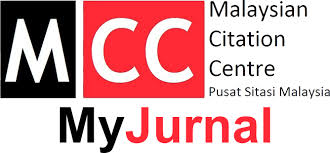Pengguguran Konsonan Obstruen-Homorganik dalam Bahasa Semai Hulu Selangor [Obstruent-Homorganic Consonants Deletion in Hulu Selangor Semai Language]
Keywords:
orang Asli; bahasa Semai; perubahan fonologi; nasal-obstruen homorganik; rumus. Aboriginal people; Semai language; phonological changes; homorganic nasal-obstruent; formula.Abstract
Makalah ini membicarakan salah satu bahasa dari kelompok orang Asli Senoi, iaitu bahasa Semai. Bahasa Semai Hulu Selangor dipilih sebagai fokus kajian kerana masyarakat bahasa ini berada terpisah daripada kelompok induknya di Perak dan Pahang. Objektif makalah ini adalah untuk menjelaskan gejala pengguguran konsonan obstruen-homorganik yang berlaku dalam bahasa Semai. Proses perubahan fonologi ini melibatkan penghilangan atau pengguguran konsonan obstruen /b, d, g/ yang mengikuti konsonan nasal /m, n, N/ pada deretan konsonan nasal-obstruen homorganik. Seramai empat orang informan berlainan jantina yang berusia dalam lingkungan 50 tahun dan ke atas telah dipilih dalam kalangan masyarakat orang Asli Semai di Kampung Serigala dan Kampung Changkat Bintang, Hulu Selangor. Data pertuturan informan dirakam dan dianalisis dengan menerapkan Teori Fonologi Generatif untuk menjelaskan gejala pengguguran konsonan obstruen-homorganik. Kajian ini mendapati bahawa gejala nasal homorganik yang berlaku dalam bahasa Semai tidak berlaku sama seperti dalam bahasa atau dialek Melayu. Dapatan mendapati segmen bunyi obstruen letupan bersuara akan digugurkan atau mengalami fenomena penghilangan daripada deretan konsonan nasal-obstruen homorganik dalam perkataan bahasa Melayu yang dituturkan dalam bahasa Semai. Perubahan yang berlaku bukan hanya melibatkan satu perubahan konsonan seperti pengguguran konsonan obstruen bersuara /b, d, g/ yang mengikuti konsonan nasal /m, n, N/, konsonan nasal /n, N/ berubah kepada /t, g/ di akhir kata, konsonan /k/ berubah kepada /// di lingkungan akhir kata dan bunyi vokal yang menerima pengaruh dari konsonan nasal. Setiap perubahan ini melibatkan rumus pengguguran obstruen bersuara, rumus nasalisasi vokal, rumus penyahnasalan dan rumus pembentukan glotis bagi menghasilkan bentuk output yang tepat sebagaimana yang diujarkan oleh penutur bahasa Semai.
This paper discusses one of the languages ??of the Senoi Aboriginal group, the Semai language. The Semai language of Hulu Selangor was chosen as the focus of the study because this language community is separated from its parent group in Perak and Pahang. The objective of this paper is to explain the symptoms of obstruent-homorganic consonant dropping that occurs in the Semai language. This process of phonological change involves the loss or dropping of the obstruent consonants /b, d, g/ that follow the nasal consonants /m, n, N/ in the row of homorganic nasal-obstruent consonants. A total of four informants of different genders aged 50 years and above were selected from among the Semai Aboriginal community in Kampung Serigala and Kampung Changkat Bintang, Hulu Selangor. The informant's speech data was recorded and analyzed by applying Generative Phonology Theory to explain the symptoms of obstruent-homorganic consonant dropping. This study found that the homorganic nasal symptoms that occur in the Semai language do not occur in the same way as in the Malay language or dialect. Findings found that the voiced plosive obstruent sound segment will be dropped or experience the phenomenon of disappearance from the homorganic nasal-obstruent consonant sequence in Malay words spoken in Semai language. The changes that occur do not only involve one consonant change such as the dropping of voiced obstruent consonants /b, d, g/ that follow nasal consonants /m, n, N/, nasal consonants /n, N/ change to /t, g/ at the end of word, consonant /k/ change to /// at the end of word as well as on vowel sounds that receive the influence of nasal consonants. Each of these changes involves the formula of dropping voiced obstruents, the formula of vocal nasalization, the formula of nasalization and the formation of the glottis to produce the correct output form as spoken by the speaker.















